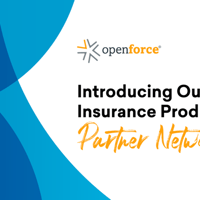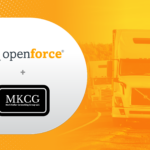PHOENIX, AZ – March 17, 2022 – Openforce, the leading software platform for managing commercial...
How rising rates for hired and non-owned auto coverage are impacting the delivery industry
Insurance rates for Hired and Non-Owned Auto (HNOA) coverage have skyrocketed over the past few years, severely impacting food delivery, final-mile, and courier businesses. HNOA insurance protects companies from liabilities associated with accidents involving vehicles that they leverage but do not own, including personal autos that are rented, leased, or owned by delivery workers but used for business purposes.
Thorough documentation, background checks, and insurance coverage verification are incredibly challenging when independent contractors and gig workers are involved. No matter the type of delivery business you run, one thing is certain: you must know who is driving on behalf of your company, and you must have policies in place for fair insurance coverage.
This article explores the factors contributing to the increase in HNOA rates and the implications for these delivery businesses and their insurance providers. It also explores why While Under Dispatch insurance is a solution for these entities that engage with independent contractors.
Factors driving the increase in Hired and Non-Owned Auto rates
The insurance landscape is ever-changing. As businesses venture further into this evolving territory, understanding the driving forces behind the uptick in HNOA rates becomes paramount. Here are the catalysts currently shaping the HNOA pricing narrative:
Increase in commercial auto accidents: As the number of vehicles on the road grows, so does the likelihood of accidents. Over the past few years, there has been a significant increase in commercial auto accidents, leading to higher claim payouts and increased HNOA rates. Distracted driving, traffic congestion, and inexperienced drivers are key factors contributing to this rise in accidents.
Rising medical and repair costs: Medical care and vehicle repairs have steadily increased, leading to higher claim payouts. As a result, insurance carriers are forced to raise HNOA rates to cover these escalating expenses.
Growth of the gig economy: The rapid expansion of the gig economy has led to a surge in the number of individuals using their personal vehicles for business purposes, increasing the demand for HNOA coverage. This heightened demand, combined with the higher risk profile of gig workers, has contributed to rising rates.
Evolving legal environment: The legal landscape surrounding the liability of businesses for accidents involving their employees or contractors has become more complex, with courts increasingly holding companies accountable. This heightened legal risk has led insurance carriers to raise HNOA rates to cover potential liabilities.
Reinsurance costs: Insurance carriers often purchase reinsurance to protect themselves from significant losses. As reinsurance costs rise due to natural disasters and global economic uncertainty, carriers may pass these costs to policyholders through higher HNOA rates.
Implications for businesses and insurance providers
For businesses:
- Budget adjustments: Companies must be prepared for increased HNOA insurance costs and adjust their budgets accordingly. This may involve reallocating resources or exploring alternative risk management strategies.
- Risk management: Businesses should implement comprehensive risk management practices, such as driver training programs, strict vehicle maintenance schedules, and the use of telematics to monitor driving habits to mitigate the impact of rising HNOA rates. Offering these programs through a third party, such as Openforce, helps alleviate the direction and control concerns with independent contractors.
- Review insurance needs: As HNOA rates increase, businesses should review their insurance needs and coverage options to ensure they are adequately protected and not overpaying for coverage.
For insurance providers:
- Pricing strategies: Insurers must carefully evaluate their rates and underwriting strategies to remain competitive while adequately pricing for the increased risks associated with HNOA coverage.
- Risk assessment: Carriers should continually refine their risk assessment processes, using advanced analytics and data-driven insights to better understand and price HNOA risks.
- Value-added services: To differentiate themselves in a competitive market, insurers can offer value-added services, such as driver safety training or telematics solutions, which can help clients reduce their risks and, ultimately, their HNOA rates.
An insightful look at While Under Dispatch solutions
The courier and delivery sector heavily relies on independent contractors driving non-commercial vehicles. Over the past few decades, obtaining proper Hired and Non-Owned Auto (HNOA) insurance coverage for this demographic has seen its share of complexities. Due to business use exclusions, the industry has witnessed a consistent surge in HNOA losses and an alarming decline in the availability and effectiveness of Personal Auto Policies (PAPs) for contractors.
This landscape began to change by introducing the While Under Dispatch (WUD) auto liability programs, offering a tailored solution for this niche. These programs provided by industry leaders like Openforce offer WUD auto liability coverage at competitive rates, in addition to driver training and safety programs. These programs alleviate direction and control concerns since the ICs receive training outside their contracting company.
WUD serves dual benefits. For contractors, it guarantees valid auto liability insurance during their dispatch period. From an underwriter's perspective, having ICs under WUD makes the standard HNOA act as excess coverage, potentially reducing premiums for delivery companies. Although not a panacea, embracing WUD programs might be the best strategy for securing affordable HNOA in the future.
As the supply chain economy evolves, it's evident that costs, including insurance, will be passed onto consumers. In this shifting landscape, businesses must find sustainable solutions, and WUD is a step in the right direction.
Driving forward
The rising rates of Hired and Non-Owned Auto coverage result from various factors, including increased commercial auto accidents, higher medical and repair costs, the growth of the gig economy, and evolving legal environments. Both businesses and insurance providers must adapt to these changing conditions by adjusting their strategies and implementing proactive risk management measures to mitigate the impact of rising HNOA rates.
Ready to learn more about While Under Dispatch insurance for your independent contractors? Reach out today to speak with one of our insurance specialists!



